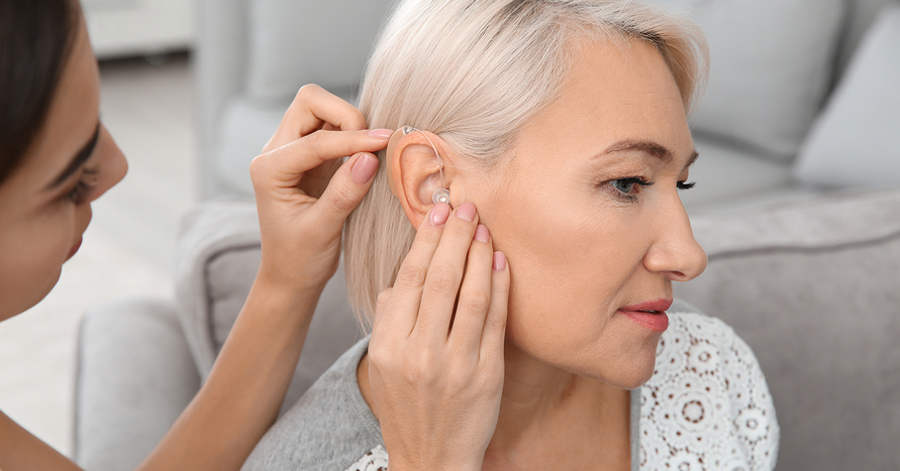Hearing loss in one ear or single-sided deafness (SSD) refers to the difficulty hearing in one ear while still hearing well in the other ear. It may be a partial or total loss in the ability to hear sounds or noise, accompanied by other symptoms.
The inability to hear may also be temporary or permanent depending on the cause. However, a hearing test can be performed to confirm unilateral deafness and how severe it is.
Hearing aids and other hearing improvement options are available and may be recommended by your audiologist at North Shore Hearing P.C. Continue reading to learn more about hearing loss in one ear and how the team at North Shore Hearing can help you experience the world more clearly.
What Causes Hearing Loss on One Side?
The causes of SSD are similar to those that lead to bilateral hearing loss or loss of hearing in both ears. Common reasons include the following:
- Ruptured eardrum due to injury or trauma
- Earwax blockage
- Blockage from a foreign body
- Congenital hearing loss
- Acoustic neuroma
- Exposure to loud noises
- Swimmer’s ear (inflammation of the outer ear)
- Middle ear infection (otitis media)
- Medications, e.g., antibiotics or chemotherapy drugs
- Illnesses, e.g., shingles or Meniere’s disease
There are also certain risk factors that increase the risk of reduced or total loss of hearing in you or your child. They include aging, family history, head trauma, or surgery to remove brain tumors. Fortunately, some of these conditions can be reversed and hearing can be restored.
Symptoms of Unilateral Hearing Loss
The symptoms associated with single-sided deafness are not much different than the symptoms associated with deafness in both ears:
- Difficulty locating the source of a sound
- Trouble isolating background noise
- Difficulty hearing in a noisy environment, e.g., a classroom or busy street
- Sounds register as softer or muffled to the affected ear
- Reduced ability to complete tasks that involve listening/hearing
Diagnosing Hearing Loss on One Side
Getting diagnosed and treated for hearing loss on one side is important regardless of if you believe you can function without hearing in the other ear. In fact, your health or safety could be at risk. For example, being unable to tell which direction a car horn sound is coming from while crossing a busy street increases the risk of an accident. Furthermore, untreated hearing loss in children can result in functional and developmental problems, according to the California Ear Institute.
Your doctor may perform an ear, nose, and throat exam when making a diagnosis. Your audiologist can perform a hearing screening or hearing test to diagnose the degree of hearing loss. You may have to listen to a range of sounds and tones at different decibel levels to help determine the part of the ear affected and the possible cause.
Treatment for Hearing Loss in One Ear
Temporary unilateral deafness may resolve on its own or may require medical intervention. Treatment options will depend on the cause of your condition. However, some causes of single-sided deafness are irreversible. In other cases, removing the blockage, treatment with medication, hearing aids, hearing devices, or surgery may be necessary to improve your ability to hear.
Ear Blockage Removal
Removing built-up wax or the foreign matter in the ear could be simply all it takes to return your hearing to normal. While over-the-counter earwax removal kits or oils are available, it is probably best to allow your doctor to decide the best course of treatment to prevent ear irritation or damage.
Do not use a cotton swab, paper clip, bobby pin, or a pair of tweezers to locate and remove the object or particle. A foreign object should be removed by your doctor who has special tools designed for this procedure.
Medication
Antibiotics, steroids, or antiviral drugs may be prescribed to clear away the ear infection, swelling, or inflammation. Sometimes stopping a course of medication can also restore hearing.
Hearing Aids/Hearing Devices
Hearing aids can significantly improve hearing in the affected ear. There are generally two types of hearing aids for hearing loss in one ear. They are the CROS (contralateral routing of signals) and BiCROS (bilateral microphones with contralateral routing of signals).CROS is designed for patients with deafness in one ear but normal hearing in the other.
The device picks up sounds directed to the affected ear and transmits them to the better ear. People with one-sided deafness who also have a degree of hearing loss in the other ear can benefit from the BiCROS hearing aid. It works by amplifying the sound directed to the affected ear so you can hear or hear better. Bone-anchored hearing devices are also available.
Surgery
A surgical procedure can be done to remove an existing tumor causing unilateral hearing loss. Or, a bone-anchored hearing device can be fitted during surgery where a titanium screw is placed in the skull bone behind the deaf ear. A sound processor is then attached on the outside of the ear. This hearing system works by reading sound vibrations and transmitting them through the skull to the hearing part of the inner ear (cochlea) of the good ear.
Contact North Shore Hearing P.C. Today
Whether you suffer from hearing in one ear or both, the experts at North Shore Hearing P.C. offer several solutions to help you experience your world more clearly. Contact North Shore Hearing P.C. today for a free hearing consultation and screening.


